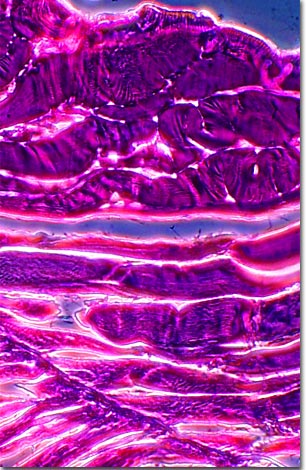Phase Contrast Image Gallery
Fish Skin
A multiply-stained thin section of fish skin is illustrated below, which was photographed using phase contrast optics. The image was captured using an Olympus IX-70 inverted microscope equipped with a DP-10 digital camera.

Fish skin or dermis is a key element in fish anatomy and may play a critical role in the swimming dynamics of these aquatic creatures. Composed of collagen fibers arranged in a crossed-helical array, fish skin connects muscle tissue with the bone infrastructure to provide a flexible network that produces an axial undulatory wave motion allowing the fish to propagate through an aqueous environment.
In addition to providing a barrier to the external environment, skin pigment patterns vary widely throughout the fish population, and are effectively utilized to provide camouflage, attract mates, and ward off predators. The outermost layer is composed of hardened, dead keratinized cells composed of scleroprotein with phospholipid side-chains. These thick layers of dead cells probably help to reduce water loss and can add oils, waxes, and lipids to waterproof the skin.
BACK TO THE PHASE CONTRAST GALLERY
